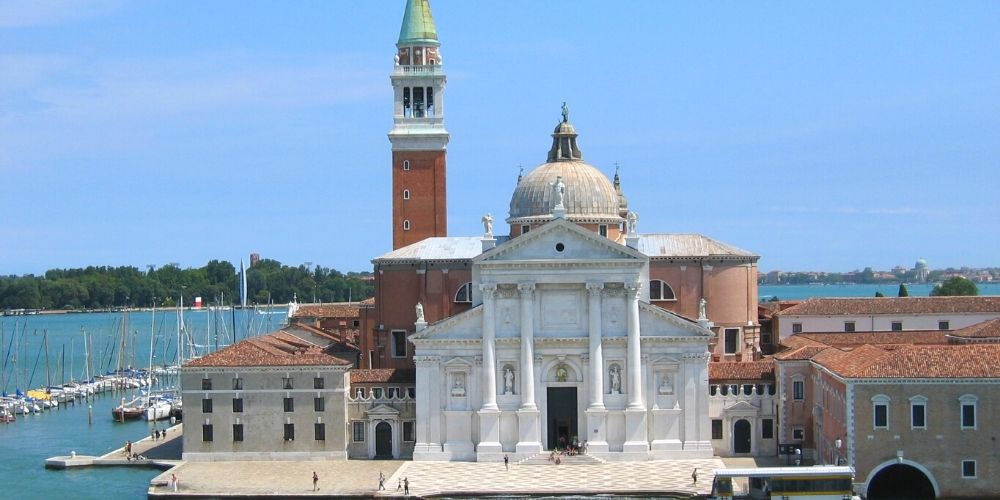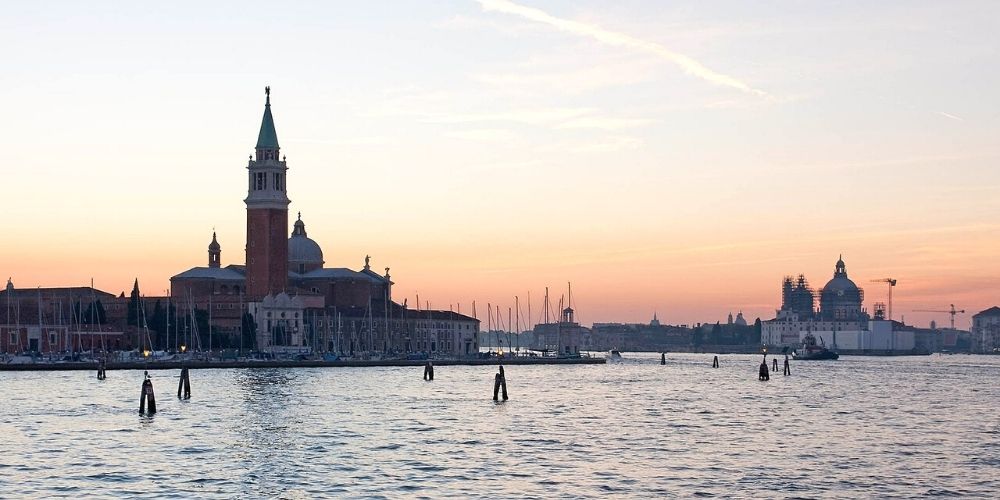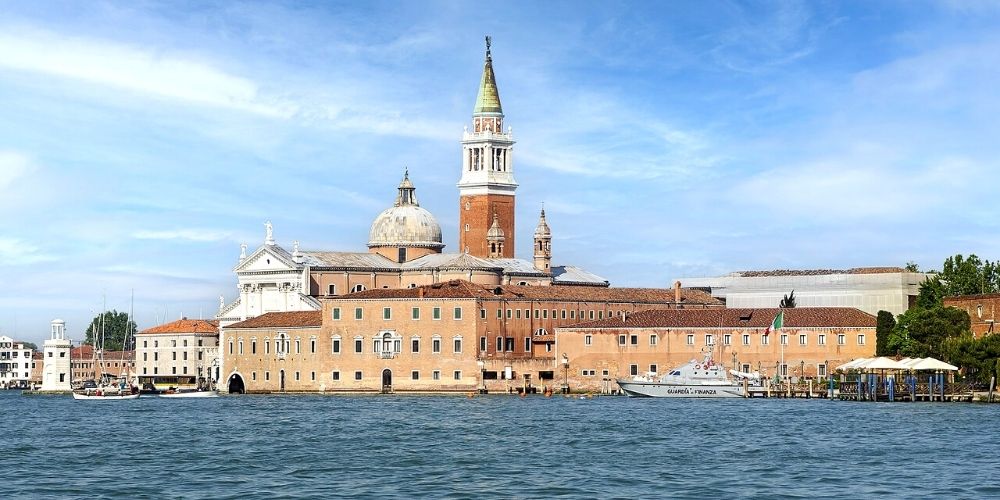When you reach the end of St. Mark's Square, at the point where the two columns look imperiously out over the lagoon, you think there can't be anything more beautiful than this.
Yet, a little further on, your eyes will finally rest on a small island with a high bell tower and it is all wonder again. The Island of San Giorgio Maggiore in Venice floats on the lagoon in all its beauty, and its elegant profiles almost seem to caress those of the nearby Giudecca.
Recently, the island of San Giorgio has been much talked about. Right here, in 2021, has opened the Borges Labyrinth, inspired by one of the short stories of the writer 'The Garden of Forking Paths'.
And of this tiny island, which houses a microcosm of history and art, we will tell you more in this article. So, the next time you come to St. Mark's Square, you will stretch your gaze to that bell tower and, perhaps, you will decide to go and explore it. In case, at the bottom of this page, we also tell you how to do it.
What to visit on the island of San Giorgio Maggiore in Venice?
On the Venetian lagoon, floats this island that, despite its small size, is the mouthpiece of stories and masterpieces, like the largest islands. Perhaps even more.
In fact, it is called 'the Major' (in Italian, 'Maggiore'), only to distinguish it from another island of the same name, San Giorgio in Alga, a semi-abandoned island in the Venetian lagoon, a greedy destination for raids.
Well, in order to talk about this island, we must start from its elegant masterpiece, the one that stands out in the panorama of San Marco: the Basilica of San Giorgio Maggiore.
The Basilica of San Giorgio Maggiore in Venice

Formerly, the island was called Memmia, because it belonged to the Memmos, a rich Venetian family. It belonged to the Memmo family until 982, when the family donated it to the Benedictine monks who built their monastery here.
About 500 years later, the project of the refectory and the extraordinary Basilica was entrusted to one of the great architects of the time. Andrea Palladio, in fact, although he only had to restructure an existing building, realized here one of his most amazing projects.
In Renaissance style, the façade of the basilica blends elements of Christian and classical flavor, creating a triangular pediment and a four-columned pronaos.
The interior is bright and houses paintings by Giacomo Tintoretto and his son Domenico. Even the wooden choir deserves a mention: each seat, in fact, made by a Flemish master, tells a different episode of the life of St. Benedict.
If the choir leaves one astonished, it is instead the Bell Tower that captures the attention of many. Very similar to St. Mark's, after having climbed its 254 foots, the vision that you have of Venice from up there does not seem true. Here the view hovers over the Basin and the Grand Canal, and reaches as far as the distant Burano and Murano.
Once back on the church square, we can visit the rest of the monastic complex, seat of the Cini Foundation. From there, we'll be closer to the magnificent Borges' Labyrinth.
The Benedictine monastery, seat of the Giorgio Cini Foundation
Splendid is also the monastic complex that today is home to the Giorgio Cini Foundation.
After World War II, the Cini family succeeded in restoring luster to the island of San Giorgio in Venice. In fact, after the removal of works of art by Napoleon, including the 'The Wedding at Cana' by Veronese, then sent to the Louvre, the island was in a state of total abandonment.
The island was used as a weapons depot and military garrison even under the Austrians, and it was only thanks to the Cini family that the course of the island's history could change.
In fact, San Giorgio Maggiore today is synonymous with elegance, art and refinement. Here the Foundation organizes exhibitions and cultural events, thanks to which it is also possible to admire the interior of the Monastery.
Such was the importance of these places in the past that in what is now called the Hall of Conclave was elected a pope in 1800: Pope Pius VII. In the hall, there is the famous painting of 'St. George killing the dragon' by Vittore Carpaccio.
Vatican Chapels and the Green Theatre: arts and faith in the Park of the Cini Foundations
Also part of the Foundation's park are the Vatican Chapels. Presented at the 2018 Architecture Biennale as the Holy See Pavilion, they were so well received that they became part of a permanent exhibition. The 11 chapels built in the woods are part of a unique way of understanding the link between architecture and faith.
A little further on, there is a mid-twentieth century building, able to accommodate up to 1500 people: it is the Green Theater. Here the stone is interspersed with boxwood plants, reminiscent of the amphitheaters of the villas of the Veneto hinterland. In building it, the Cini Foundation wanted to commit itself concretely in giving vigor to the cultural events on the island, with the collaboration of both the Fenice and the Biennale.
And from the woods of the Biennale, it is a must to visit another of the most incredible parks of Venice, the Labyrinth of Borges.
Borges Labyritinth: a tale of arts and nature
For many visitors, the island of San Giorgio is synonymous with Borges Labyrinth. Until 2021, the labyrinth was only visible from the top of the Centro Branca, and its photographs and videos gave rise to flights of fancy.
So, in the 'labyrinth city', as Borges' widow Maria Kodama called Venice, it is now possible to visit the 'magic gift' that the English architect Randoll Coate gave to the writer.
In one of Borges' most beloved cities, one of the most beautiful parks in Italy came to life in 2011, thanks to the Cini Foundation, and it is certainly a literary labyrinth where what is impalpable is much more than what is real.
Borges' name also comes to life in the high hedges that outline his surname, together with other symbols scattered among the 3200 boxwood plants. To stroll, to lose oneself and to find oneself again, as in a garden of forking paths.
How to get to the island of San Giorgio Maggiore in Venice
If all this has intrigued you, and it could not be otherwise, you should know that there are 4 ways to get to the island of San Giorgio Maggiore, thanks to the public service of Venice (line 2 ACTV):
- from San Zaccaria (about a 3 minute trip);
- from the railway station (about 45 minutes' journey);
- from Piazzale Roma (about 40 minutes);
- from Tronchetto (about 35 minutes).













Lascia un commento